Installation of heating from polypropylene pipes: how to make a heating system from polypropylene
Polypropylene pipes are increasingly becoming a successful replacement for steel and cast iron analogues that were previously used in plumbing.Many private houses under construction are now equipped with heating systems, hot water supply and hot water supply, mounted on the basis of polypropylene.
In addition, installation of heating from polypropylene pipes is easy to do yourself. In any case, it is much easier to build a plastic system than a metal one.
The content of the article:
Heating based on polypropylene
If you decide to make a heating system or any other system from polypropylene pipes, the master will need additional equipment in addition to plastic hoses.
In particular, you will need the following material, equipment, and tools:
- pipe shears or pipe cutter;
- soldering plumbing machine;
- foil remover;
- sealing tape (fluoroplastic);
- sharp knife;
- degreaser (for example, Tangit wipes);
- required range of fittings;
- tape measure and marker;
- fasteners, screws and dowels.
You should pay attention to the main material - PP pipes, from which it is supposed to create a heating system. Because a heating system made of polypropylene pipes can be assembled using materials of different classes.
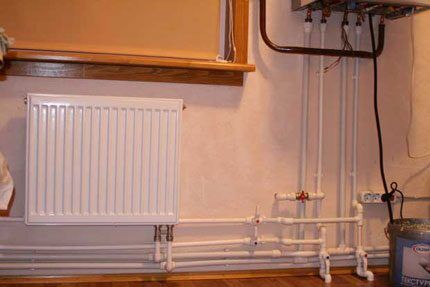
The specific choice of assembly depends on the planned operating conditions.
Classification and design parameters
Existing GOST standards (ISO10508) establish a classification of polypropylene hoses, based on which this material can be used under certain operating conditions.
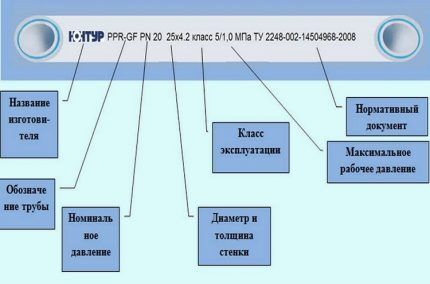
Long polypropylene products are divided into 4 classes (1.2, 4.5) according to typical areas of application and operating pressure values (4,6,8,10 ATI):
- class 1 (hot water systems up to 60°);
- class 2 (hot water systems up to 70°C);
- class 4 (underfloor heating and radiator systems up to 70°C);
- class 5 (radiator systems up to 90°C).
For example, polypropylene pipes are required to make a low-temperature heating system. Then, by the designation on the outer surface of the pipes, you can determine the appropriate material.
For this case, hoses with the designation Class 4/10 are quite suitable, which corresponds to the limiting temperature parameter of 70ºС and the permissible operating pressure limit of 10 ATI.
Industry, as a rule, produces products for universal use. The manufactured products support an extensive classification. In the documentation for such material PP pipe marking indicated by a standard listing of acceptable parameters (Class 1/10, 2/10, 4/10, 5/8 bar).
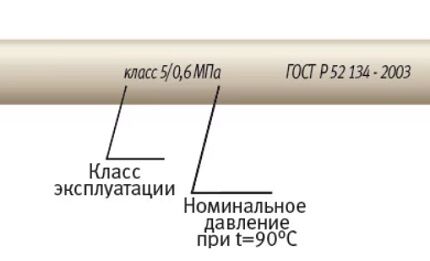
Thus, when planning to make heating in a polypropylene house with your own hands, the main material is usually chosen by the master in direct proportion to:
- from planned operating parameters;
- on methods of heating the coolant;
- on the applied regulatory system.
It is also advisable to calculate the service life of the future heating system using the following parameters:
- upper values Trab and Prab;
- pipe wall thickness;
- outside diameter;
- safety factor;
- duration of the heating season.
On average, the service life of polypropylene should be at least 40 years.
Stages of assembling a system from PP pipes
Let's see how to do it polypropylene pipeline taking into account installation standards and regulations. The start of network production should be preceded by a careful inspection of all parts of the future system kit. Components (pipes, fittings) must be in good condition - clean and free of damage.
It is recommended to use parts from only one manufacturer. The ambient temperature of the work site is at least + 5°C.
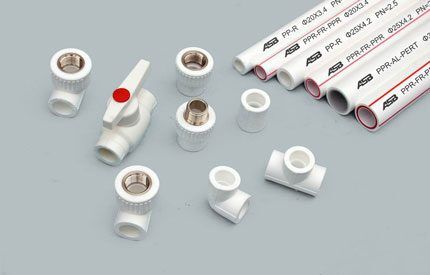
Polypropylene parts of the system can be connected to each other using one of three types of welding:
- Polyfuse.
- Electrofusion.
- Butt.
For assembling heating and plumbing systems, they produce not only polypropylene pipes and fittings for welding. They also produce special threaded fittings necessary for installing shut-off and control valves with metal bodies.
On polypropylene pipes themselves, thread cutting is not done either in a factory or at home. They are connected only by hot, less often by cold welding.
Features of installation work
All components used in installation, in cases of adjusting them to size, cut with a pipe cutter or scissors specially designed for this purpose.
Working with this tool is accompanied by an even, clean cut, which is an important point for making a quality connection.

If it is necessary to make a “plastic-to-metal” transition, on hot water supply and heating pipelines it is necessary to use exclusively fitting transitions equipped with a pressed-in brass (nickel-plated) bushing with threads (internal or external). Tightening of such connections is carried out using strap wrenches if there is no profile for a standard wrench.
Traditionally, a heating pipeline made of polypropylene, including with your own hands, is assembled using the alloy method polyfusion welding machine. The working set of devices for devices of this kind contains a group of nozzles made for different diameters of plastic pipes.
It is necessary to select suitable nozzles, install them on the heating plate and secure them with screws.
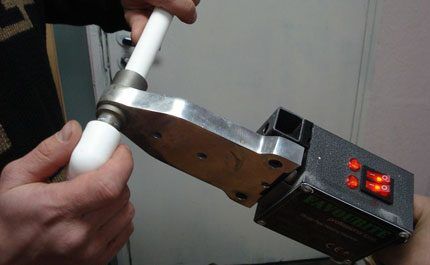
The current regulator of the polyfusion welding machine is set working temperature, as a rule, 250-270°C. You must wait until the device warms up completely. The achievement of the operating mode is indicated by a control LED.
Some devices are equipped with a contact thermometer, which determines the heating temperature with an accuracy of one degree.
Polypropylene Welding Procedure
Step by step, all actions usually unfold as follows:
- Measure and cut the required piece of sleeve.
- Using a sharp knife, chamfer the working end at an angle of 30-40°.
- Measure the area where the sleeve enters the fitting and mark the boundary with a marker.
- Also leave axial marks on the parts to prevent rotational displacement.
- Using a trimming device, remove the plastic (top) and aluminum (middle) layers from the pipe section of the joint.
- Degrease the working (welded) surfaces with a special product.
- Proceed with the heating procedure of the parts.
The fitting is put on the board with the nozzle first, given the thicker size of the walls of this part compared to the pipe. The fitting should fit tightly onto the body of the welding machine nozzle. If there is free movement (play, looseness), the fitting must be rejected.
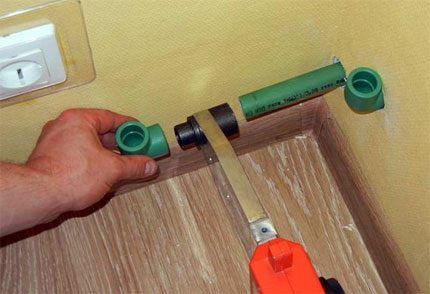
Next, the treated end of the polypropylene pipe is inserted into another nozzle. The fit density here must also meet the criterion of uniform contact around the entire circumference. Both parts are kept on the heating plate for the time indicated in the table:
| Part diameter, mm | Heating time, sec |
| 16 | 5 |
| 20 | 5 |
| 25 | 7 |
| 32 | 8 |
| 40 | 12 |
| 50 | 18 |
| Part diameter, mm | Fixation time, sec |
| 16 | 6 |
| 20 | 6 |
| 25 | 10 |
| 32 | 10 |
| 40 | 20 |
| 50 | 20 |
After the control seconds have passed, the parts are removed from the nozzles and connected by a smooth, uniform entry of the pipe into the fitting (excluding axial displacement).
The pipe enters the fitting cavity up to the marker mark. However, the connection is not made all the way. It is necessary to leave an internal gap of about 1 mm.
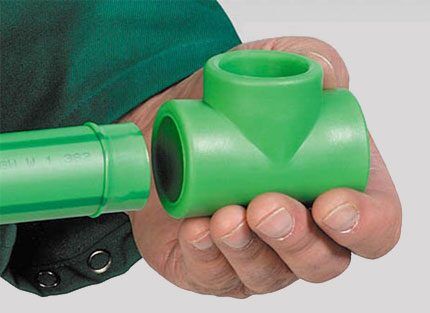
After connections of PP pipes by soldering the place where the parts are joined must remain motionless (fixed) for at least 20 seconds. During this period of time, the molten plastic hardens, forming a strong, sealed joint.
To achieve full strength, the welded assembly must be kept without load for at least 1 hour. This technique is used to assemble the entire heating system, making short sections and then combining them into nodes and main lines.
Accounting for linear expansion (compression)
Fluctuations in external and internal temperatures inevitably lead to linear expansion or contraction of polypropylene. These features should be taken into account in the process installation of PP pipelines. If the characteristic linear changes in the heating system piping are not adequately compensated for, this condition will result in a shortened service life of the entire assembly.
Compensation for linear expansion for polypropylene products is achieved due to the flexible properties of the material itself. You just need to lay the main lines correctly. Correct installation means ensuring freedom of movement of the pipeline within the limits of linear expansion.
How to ensure such installation? Very simple. The installation kit must include special compensators and standard fastening clamps consisting of fixed and moving elements.
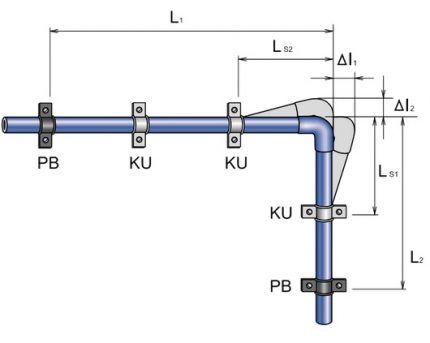
Linear expansion can also be compensated by prestressing the pipeline. This approach reduces the extension length. In this case, the direction of prestress is directly opposite to linear expansion.
Features of mainline installation
Laying polypropylene lines at gravity heating device is carried out in accordance with standards (GOST 21.602-79; GOST 21.602-2003), which determine the minimum slope of the line towards the lowest point at 0.5%. In this case, a drainage unit with a drain tap must be placed at the lowest point.
Pipelines must be divided into sections with the possibility of shutting off these sections using shut-off valves, for example, in case of an accident. Before installing them on site, control valves and stopcocks must be checked for functionality and quality of closing/opening.
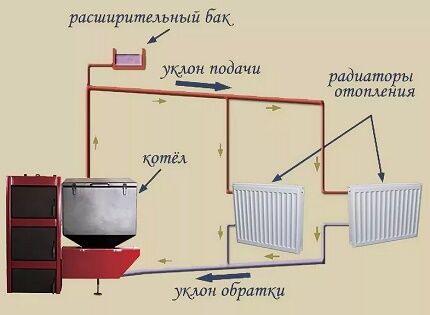
When installing risers, special attention should be paid to fixed supports and the construction of a correct linear expansion compensation scheme.
The required riser compensation parameter can be achieved in two ways:
- Movable supports.
- Compensation loop.
For the heating installation option within ordinary household real estate, as a rule, only the first method is used. Fixed supports are placed on the riser in the area below and above the tee or in the places where the pipes are coupled. This fastening prevents subsidence of the riser.
Heating system lines must be insulated, including fittings and shut-off valves. The exception is pipe sections laid directly in the living space, which are essentially a continuation of heating radiators. It is convenient to use polyurethane foam insulating pipes as insulation.
Conclusions and useful video on the topic
Using the example of piping a heating radiator, the process of processing and soldering polypropylene products using special tools is shown.
The appearance of pipes made on the basis of polypropylene and their use in business can significantly reduce the complexity of installation of heating systems, including with your own hands. This modern material opens up more opportunities for owners of private houses, where heating systems are powered from internal sources - gas, electric, wood boilers.
Tell us about your own experience gained during the assembly of a pipeline from polypropylene pipes. Share with site visitors useful technological nuances not covered in the article. Please write comments in the block below, ask questions, post photos on the topic of the article.




I would like to independently install a similar system of polypropylene pipes at home in order to be completely confident in the quality of the connections and protect myself from the hack work of the performers. But what confuses me is this: how much will it cost to purchase the necessary equipment for welding pipes? I consider a significant disadvantage of a polypropylene pipe to be that it cannot be bent; unlike a metal-plastic pipe, it does not bend at all.
I also screwed it up at first, and then I re-soldered everything in my house - and nothing leaked! The soldering iron is cheap - 2-3 thousand. All the equipment is there - read the instructions and you will succeed! Good luck!
This is the first time I’ve heard about degreasing pipes before soldering. There are so many unnecessary movements that need to be made, and the soldering iron will burn out. In my opinion, no one does this, this was about 20 years ago, when plastic was adhesive.
And linear expansion on polypropylene can be minimized using expansion joints. This, of course, will slightly increase the cost of installation, but there will be no bent pipes.
What are compensators, can you be more specific?
You warm it with a hairdryer and bend it. I made it at home with a soldering iron for 700 rubles. It has been working for 3 years without problems. The main thing is to buy quality pipes.